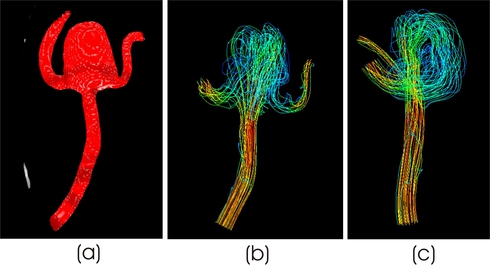Dr.-Ing. Martin Spiegel
Alumnus of the Pattern Recognition Lab of the Friedrich-Alexander-Universität Erlangen-Nürnberg

Cerebral Vessel Segmentation and Blood Flow Simulations
Stroke is the third most common cause of death in the western world with 10-15% caused by intracerebral hemorrhage, e.g. rupture of an aneurysm. Today most of aneurysms are detected by accident and the reason of their appearance is not clear. Blood flow simulations will help physicians to provide a better diagnosis with respect to the risk of rupture by getting a closer look on occurring flow pattern. For instance, Castro et al. [1] analyzed the correlation between hemodynamic patterns and aneurysmal rupture. This work concentrates on the segmentation of cerebral vessel structures. For CFD the vessel geometry is the most prominent boundary condition. Therefore an evaluation of the influence of different segmentation results on resulting flow pattern will be included. Figure 1 (b) and (c) depicts one example of flow pattern where the blood inflow gets divided into two branches within the aneurysm.
State-of-the-art vessel segmentation techniques are statistical-based methods [2] and level-set formulations [3]. The basic concept of this work is to develop a segmentation algorithm combining 2-D and 3-D information in order to improve segmentation results. The first step will be to introduce a level-set based segmentation method whose level-set formulation is regularized in a way that tubular structures like vessels are easily segmented and non-tubular structures get penalized. Figure 1 (a) shows an initial result of a segmented vessel structure.
Phantom experiments, contrast agent flow experiments and sensitivity analysis of the segmentation results denote future work in the context of this project. The phantom experiments together with the sensitivity analysis will build a base to get a profound knowledge how different segmentation results will influence flow pattern resulting from CFD simulation.
Moreover, a time parameterization of the pixel intensities within 2-D digital substracted angiograms (DSA) seems to be a promising way to gain more information about flow pattern within real vessel pathologies. These can be drawn in comparison to "virtual angiograms" representing the flow pattern computed from the CFD simulation.
[1] Castro, Marcelo; Putman, Christopher; Radaelli, Allesandro; Frangi, Alejandro; Cebral, Juan:
Image-Based Investigation of Hemodynamics and Rupture of Cerebral Aneurysms of a Single Morphological Type: Terminal Aneurysms,
Proc. of SPIE Medical Imaging 2008: Physiology, Function and Structure from Medical Images, San Diego, USA
[2] Gan, Rui; Chung, A.C.S.; Wong, W.C.K.; Yu, S.C.H:
Vascular segmentation in three-dimensional rotational angiography based on maximum intensity projections,
IEEE International Symposium on Biomedical Imaging: Nano to Macro, 2004, vol. 1, pp.133-136
[3] Deschamps, Thomas; Cohen, Laurent D.:
Fast Extraction of Tubular and Tree 3-D Surfaces with front propagation methods,
In Proc. of 16th ICPR, 1:731 -734, 2002
This project is funded by Siemens AG Healthcare, AX, Forchheim, Germany.
The medical support of the Department of Neuroradiology, University Erlangen-Nuremberg, is acknowledged.




